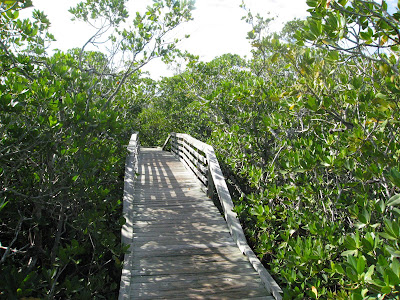 This morning, we walked the park's elevated walkway trail through the mangroves. Mangroves are one of the few land woody plants that can withstand saltwater and they grow in up to 3 ft. of water all along the coasts, often completely obscuring the land from view from the sea and creating thickets and jungles hundreds of yards deep.
This morning, we walked the park's elevated walkway trail through the mangroves. Mangroves are one of the few land woody plants that can withstand saltwater and they grow in up to 3 ft. of water all along the coasts, often completely obscuring the land from view from the sea and creating thickets and jungles hundreds of yards deep.
Where the water is deeper, the mangroves can't grow and it leaves a maze of waterways. We piloted Nonchalance through large mangrove waterways like this to get here. In the big channels used by all the boats, if you stay in the middle there is 6 to 10 ft of water.
 Within the thickets when you look down you don't see ground, you just see water (or sometimes wet mud depending on the tides) and an impenetrable system of roots. Needless to say, this is impossible for humans to get through, but an excellent habitat for many creatures that call it home, including millions of tiny fish that hide out amoung the mangrove roots, using it as a nursery until they grow big enough to venture out into open water.
Within the thickets when you look down you don't see ground, you just see water (or sometimes wet mud depending on the tides) and an impenetrable system of roots. Needless to say, this is impossible for humans to get through, but an excellent habitat for many creatures that call it home, including millions of tiny fish that hide out amoung the mangrove roots, using it as a nursery until they grow big enough to venture out into open water.Then, this afternoon, we went snorkeling at John Pennekamp coral reef, which is about 4 miles out in the ocean.
 We went out in this snorkle trip boat with 45 other snorkelers. That's Kathy on the stern corner of the boat putting on her mask and snorkle. Waves were only about 1 ft. in the ocean at the reef. The Atlantic doesn't get much more calm than that!
We went out in this snorkle trip boat with 45 other snorkelers. That's Kathy on the stern corner of the boat putting on her mask and snorkle. Waves were only about 1 ft. in the ocean at the reef. The Atlantic doesn't get much more calm than that!
The reef is beautiful. Lots of colorful fish, corals, sea fans and sponges in about 6 to 15 ft. of water. Visibility was about 50 ft., which s very good.

 We wore wetsuits and were comfortable even though the water is cool when you first get in.
We wore wetsuits and were comfortable even though the water is cool when you first get in.
 It was incredible how many barracuda there were. All of these in this group are about 3 ft. long or more.
It was incredible how many barracuda there were. All of these in this group are about 3 ft. long or more.
 There were the usual French Grunts hanging around the ledges and sea fans. These are each about 8 inches long.
There were the usual French Grunts hanging around the ledges and sea fans. These are each about 8 inches long.

 We wore wetsuits and were comfortable even though the water is cool when you first get in.
We wore wetsuits and were comfortable even though the water is cool when you first get in. It was incredible how many barracuda there were. All of these in this group are about 3 ft. long or more.
It was incredible how many barracuda there were. All of these in this group are about 3 ft. long or more. There were the usual French Grunts hanging around the ledges and sea fans. These are each about 8 inches long.
There were the usual French Grunts hanging around the ledges and sea fans. These are each about 8 inches long.
Kathy spotted this Queen Angelfish, about 1 ft. long. It's one of the best, most colorful reef fish to see, and not very common. You can see the bright blue "crown" around a black spot on its forehead.

And we saw the common "river of purple fish" which is a school of surgeonfish, so called because they have an extremely sharp spine (like a scalpel blade) on each side near their tail, with which they can slice other fish, or even unsuspecting divers hands, if you were to grab one.
1 comment:
The underwater photos are exceptional. I especially like the blue surgeon fish.
Post a Comment